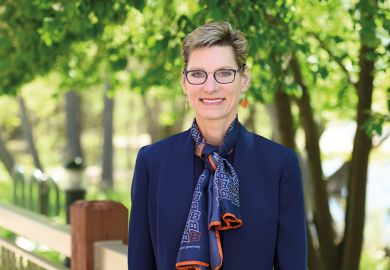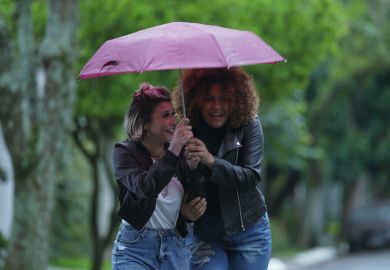In a nation of debilitating political division along rural-urban lines, the biggest public university in one of the most conservative US states may be finding a pathway to understanding.
Like many public higher education leaders, Boise State University president Marlene Tromp feels pressure to prove the statewide value of her institution.
Her challenge, however, looms a bit tougher than many others. Idaho ranks near the bottom of US states on measures such as wealth and mental well-being, and its people twice voted by two-to-one margins for Donald Trump and his anti-intellectual ideologies.
When Dr Tromp arrived last year at Boise State, half the Republican majority in the Idaho House of Representatives sent her a letter complaining that ongoing campus diversity campaigns were not “the Idaho way” and must be stopped.
“I had one legislator say to me: ‘I don’t want a white kid from a small town in Idaho to show up on campus and not understand the conversations that are taking place and to feel ashamed,’” she said.
Yet in tackling that challenge, Dr Tromp came to Boise State with important pieces of experience. One, she is a first-generation college graduate from a small town just over the border in Wyoming.
Second, her past experience included time as a dean at Arizona State University (ASU), where she found a way to engage rural communities that also felt overlooked and marginalised by higher education.
In that case, it was the Gila River Indian Community on the southern edge of Phoenix. There, tribal leaders were deeply suspicious that a big institution like ASU had any interest in or ability to meaningfully help them.
Dr Tromp met with Gila River leaders to hear them out. She learned that they most wanted teaching in schools to be done by their own tribal members, and responded with a mix of in-person and online classes created by ASU’s College of Education.
That led to a graduation rate of 88 per cent – a score typically found at only the most elite US institutions – with 50 per cent of the students moving forward to graduate school.
“The success rate just went through the roof,” she said.
Now Dr Tromp is trying the same thing in Idaho. Before the coronavirus pandemic moved much of higher education online, she made a commitment to establish programmes in three small Idaho towns where students would have both online classes and faculty stationed locally to help out.
While state lawmakers had faulted Boise State for pursuing racial and gender equity, the idea reflects a bid by Dr Tromp to expand the concept of diversity to include rural students and communities that feel they have been ignored by their far-away universities.
For her, it’s personal, having seen rural communities suffer slow deaths when young people move away, leaving elderly residents with too few neighbours to support theatres, grocery stores and doctors.
“I grew up in a small community in Wyoming,” Dr Tromp said. “And I’ve watched city after city die.”
That worry motivated her to make a special effort to encourage training in careers such as cybersecurity, which can be done remotely, allowing graduates to remain near their home towns.
And while Dr Tromp has stressed the need to listen to local businesses and take their workforce needs into account, she presses them to understand that a mix of liberal arts and job-specific training works best.
Dr Tromp appears to have made progress with lawmakers. The one who asked her about small-town kids feeling ashamed at Boise State grew much friendlier after hearing that she had battled similar anxieties as an undergraduate at Creighton University, more than 700 miles from her Wyoming home.
Her ultimate success remains unclear, given the fraught political moment and dire economic circumstances facing Idaho and much of the country a year into the pandemic.
Boise State’s annual state budget of about $235 million (£175 million) is already down about $25 million this year, offset by only about $15 million in federal Covid relief.
And with the state legislature due to gather in January to set the next annual budget, Dr Tromp expects more cuts and hopes they won’t be too severe.
By the numbers, Boise State would seem to have a strong argument, with data showing that the 26,000-student institution has a $2 billion annual impact on Idaho’s economy. But political agendas remain powerful.
“They’re very serious about continuing to cut the university,” Dr Tromp said of state lawmakers. “The thinking is that they can stop us from doing things that they see as ideologically threatening.”
POSTSCRIPT:
Print headline: US campus tries rural outreach to bridge divide
Register to continue
Why register?
- Registration is free and only takes a moment
- Once registered, you can read 3 articles a month
- Sign up for our newsletter
Subscribe
Or subscribe for unlimited access to:
- Unlimited access to news, views, insights & reviews
- Digital editions
- Digital access to THE’s university and college rankings analysis
Already registered or a current subscriber?








